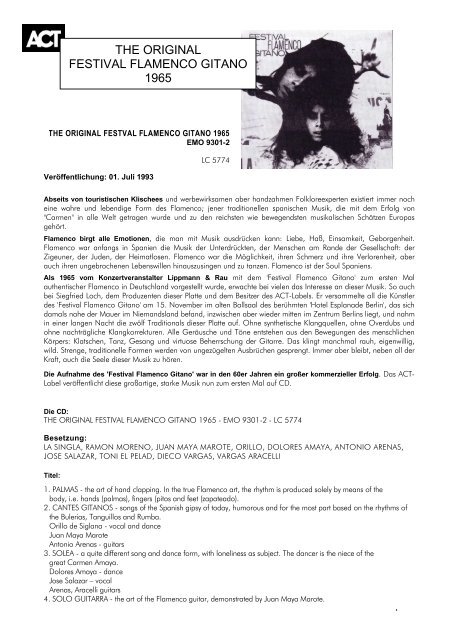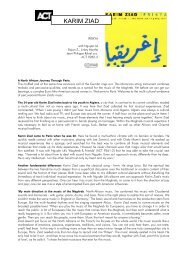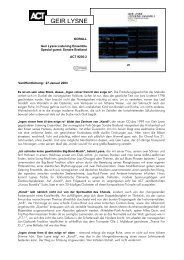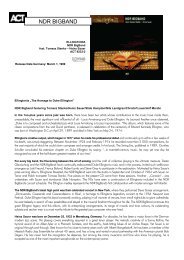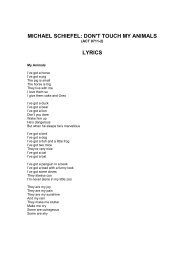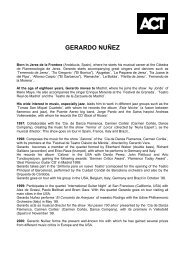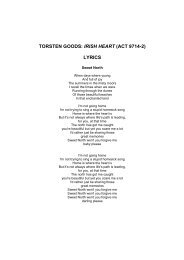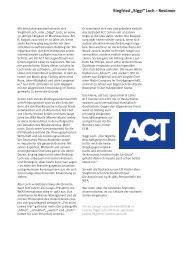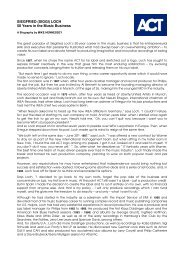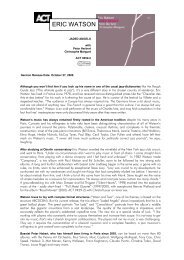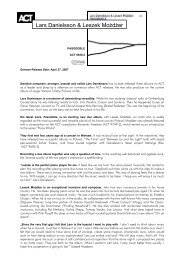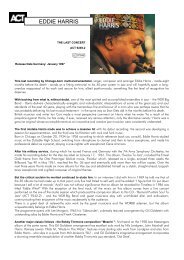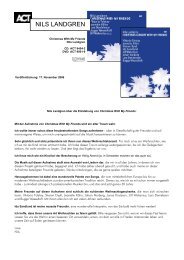THE ORIGINAL FESTIVAL FLAMENCO GITANO 1965
THE ORIGINAL FESTIVAL FLAMENCO GITANO 1965
THE ORIGINAL FESTIVAL FLAMENCO GITANO 1965
You also want an ePaper? Increase the reach of your titles
YUMPU automatically turns print PDFs into web optimized ePapers that Google loves.
Abseits von touristischen Klischees und werbewirksamen aber handzahmen Folkloreexperten existiert immer noch<br />
eine wahre und lebendige Form des Flamenco; jener traditionellen spanischen Musik, die mit dem Erfolg von<br />
"Carmen" in alle Welt getragen wurde und zu den reichsten wie bewegendsten musikalischen Schätzen Europas<br />
gehört.<br />
Flamenco birgt alle Emotionen, die man mit Musik ausdrücken kann: Liebe, Haß, Einsamkeit, Geborgenheit.<br />
Flamenco war anfangs in Spanien die Musik der Unterdrückten, der Menschen am Rande der Gesellschaft: der<br />
Zigeuner, der Juden, der Heimatlosen. Flamenco war die Möglichkeit, ihren Schmerz und ihre Verlorenheit, aber<br />
auch ihren ungebrochenen Lebenswillen hinauszusingen und zu tanzen. Flamenco ist der Soul Spaniens.<br />
Als <strong>1965</strong> vom Konzertveranstalter Lippmann & Rau mit dem 'Festival Flamenco Gitano' zum ersten Mal<br />
authentischer Flamenco in Deutschland vorgestellt wurde, erwachte bei vielen das Interesse an dieser Musik. So auch<br />
bei Siegfried Loch, dem Produzenten dieser Platte und dem Besitzer des ACT-Labels. Er versammelte all die Künstler<br />
des 'Festival Flamenco Gitano' am 15. November im alten Ballsaal des berühmten 'Hotel Esplanade Berlin', das sich<br />
damals nahe der Mauer im Niemandsland befand, inzwischen aber wieder mitten im Zentrum Berlins liegt, und nahm<br />
in einer langen Nacht die zwölf Traditionals dieser Platte auf. Ohne synthetische Klangquellen, ohne Overdubs und<br />
ohne nachträgliche Klangkorrekturen. Alle Geräusche und Töne entstehen aus den Bewegungen des menschlichen<br />
Körpers: Klatschen, Tanz, Gesang und virtuose Beherrschung der Gitarre. Das klingt manchmal rauh, eigenwillig,<br />
wild. Strenge, traditionelle Formen werden von ungezügelten Ausbrüchen gesprengt. Immer aber bleibt, neben all der<br />
Kraft, auch die Seele dieser Musik zu hören.<br />
Die Aufnahme des 'Festival Flamenco Gitano' war in den 60er Jahren ein großer kommerzieller Erfolg. Das ACT-<br />
Label veröffentlicht diese großartige, starke Musik nun zum ersten Mal auf CD.<br />
Die CD:<br />
<strong>THE</strong> <strong>ORIGINAL</strong> <strong>FESTIVAL</strong> <strong>FLAMENCO</strong> <strong>GITANO</strong> <strong>1965</strong> - EMO 9301-2 - LC 5774<br />
Besetzung:<br />
LA SINGLA, RAMON MORENO, JUAN MAYA MAROTE, ORILLO, DOLORES AMAYA, ANTONIO ARENAS,<br />
JOSE SALAZAR, TONI EL PELAD, DIECO VARGAS, VARGAS ARACELLI<br />
Titel:<br />
<strong>THE</strong> <strong>ORIGINAL</strong><br />
<strong>FESTIVAL</strong> <strong>FLAMENCO</strong> <strong>GITANO</strong><br />
<strong>1965</strong><br />
<strong>THE</strong> <strong>ORIGINAL</strong> FESTVAL <strong>FLAMENCO</strong> <strong>GITANO</strong> <strong>1965</strong><br />
EMO 9301-2<br />
Veröffentlichung: 01. Juli 1993<br />
LC 5774<br />
1. PALMAS - the art of hand clapping. In the true Flamenco art, the rhythm is produced solely by means of the<br />
body, i.e. hands (palmas), fingers (pitos and feet (zapateado).<br />
2. CANTES <strong>GITANO</strong>S - songs of the Spanish gipsy of today, humorous and for the most part based on the rhythms of<br />
the Bulerias, Tanguillos and Rumba.<br />
Orillo de Siglana - vocal and dance<br />
Juan Maya Marote<br />
Antonio Arenas - guitars<br />
3. SOLEA - a quite different song and dance form, with loneliness as subject. The dancer is the niece of the<br />
great Carmen Amaya.<br />
Dolores Amaya - dance<br />
Jose Salazar – vocal<br />
Arenas, Aracelli guitars<br />
4. SOLO GUITARRA - the art of the Flamenco guitar, demonstrated by Juan Maya Marote.<br />
1
<strong>THE</strong> <strong>ORIGINAL</strong> <strong>FESTIVAL</strong> <strong>FLAMENCO</strong> <strong>GITANO</strong> <strong>1965</strong><br />
5. ALEGRIA (or Alegrias - to the confusion of non-Spaniards, the names of the Flamenco forms are used in the plural<br />
as well as in the singular). One of the main forms in Flamenco art.<br />
Toni el Pelao - dance<br />
Jose Salazar - vocal<br />
Marote, Arenas – guitars<br />
6. FANDANGOS NATURALES - the "natural", original form of the Fandango. Ramón Moreno-vocal<br />
Foto: Jörg Becker/ACT<br />
Aracelli – guitar<br />
7. POR FIESTA - a bold union of song and dance, in which themes from Central and South America join the<br />
Flamenco rhythms.<br />
La Caneta - vocal and dance<br />
Marote, Arenas, Aracelli – guitars<br />
8. LA CANA - is held to be the mother of all Flamenco song and dance forms. lt is thought that several centuries ago,<br />
it was a purely religious song.<br />
Salazar - vocal<br />
Arenas – guitar<br />
9. SIGUIRIYAS - One of the larger forms, and purely a gipsy creation. Song and dance are very closely combined,<br />
and the theme is bitterness, pain and death, Lorca admired the Siguiriyas as the most poetic and profound of<br />
Flamenco art forms. La Singla interprets this dance with all the vehemence of her youthful talent.<br />
La Singla - dance and "pitos"<br />
Diego Vargas - vocal<br />
Juan Maya Marote – guitar<br />
10. SAETA - This unaccompanied religious lament is only sung during Holy Week in Andalusia. The<br />
Saeta is in all probability purely Jewish in origin: when the Jews in Spain, forcibly converted to Christianity had to<br />
express in public their sorrow at the death of Christ, they used for their lament the melodies of their forbidden<br />
synagogues, as a means of affirming among themselves their old faith. The sensitive Andalusians (and Gitanos)<br />
came to adopt them, and have retained them as the Saeta (= arrow). Ramon Moreno, who has five times won the<br />
prize for the best Saeta singer in Cadiz, demonstrates the very specialised art of this Flamenco song form.<br />
Ramón Moreno – vocal<br />
11. FANDANGOS DE HUELVA - Fandangos have been known since the 17th century as castanet<br />
dances. The Gitanos, however, treat them as song forms, thus more closely approaching the origins of the form in<br />
Moorish (possibly even Phoenician) songs.<br />
Orillo and Vargas - vocal<br />
Aracelli – guitar<br />
12. RUMBA CATALAN - The most modern Flamenco song and dance form.<br />
Orillo and Vargas - vocal<br />
Marote, Aracelli, Arenas - guitars<br />
The Legendary Recording of November 15, <strong>1965</strong> in Berlin<br />
PRODUCED BY SIEGFRIED LOCH<br />
Concert tour produced and presented by Lippmann & Rau.<br />
Engineer: Peter Kramper<br />
Digital Mastering by Greg Calby Sterling Sound New York<br />
Art work by Günther Kieser<br />
All titles traditional / PD<br />
Vertrieb:<br />
Edel Contraire (D), Edel Musica Austria (A), Musikvertrieb (CH)<br />
Ehrengutstrasse 28, 80469 München, Germany<br />
Phone +49 89 72 94 92 0, Fax +49 89 72 94 92 11<br />
e-mail: info@actmusic.com<br />
Visit our website at http://www.actmusic.com<br />
2


